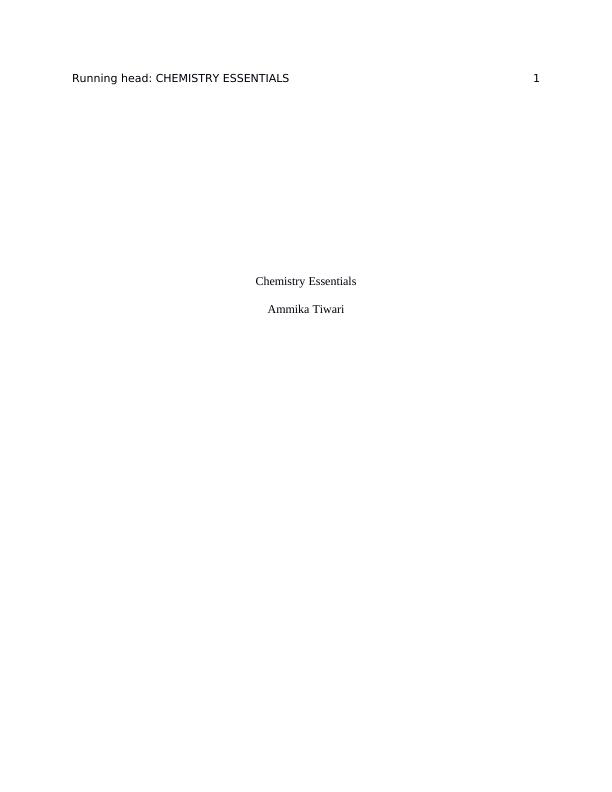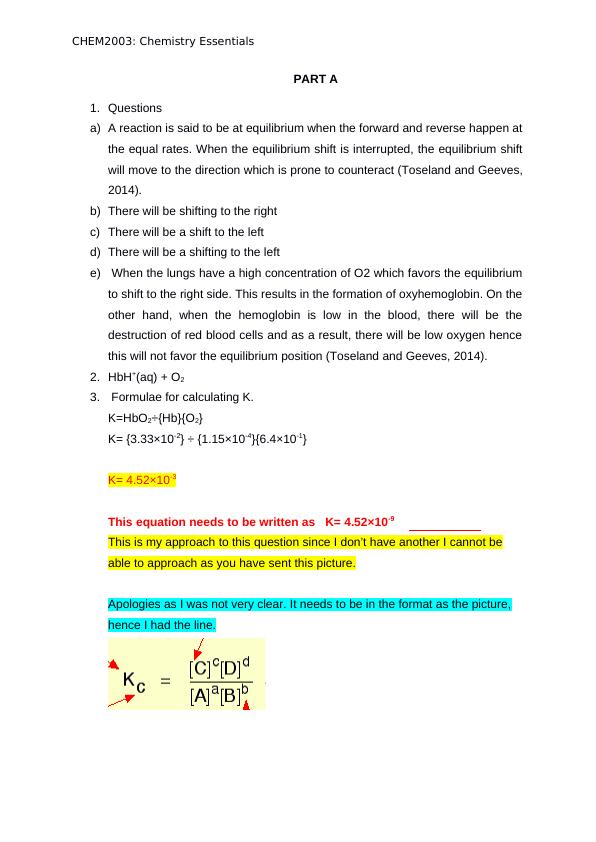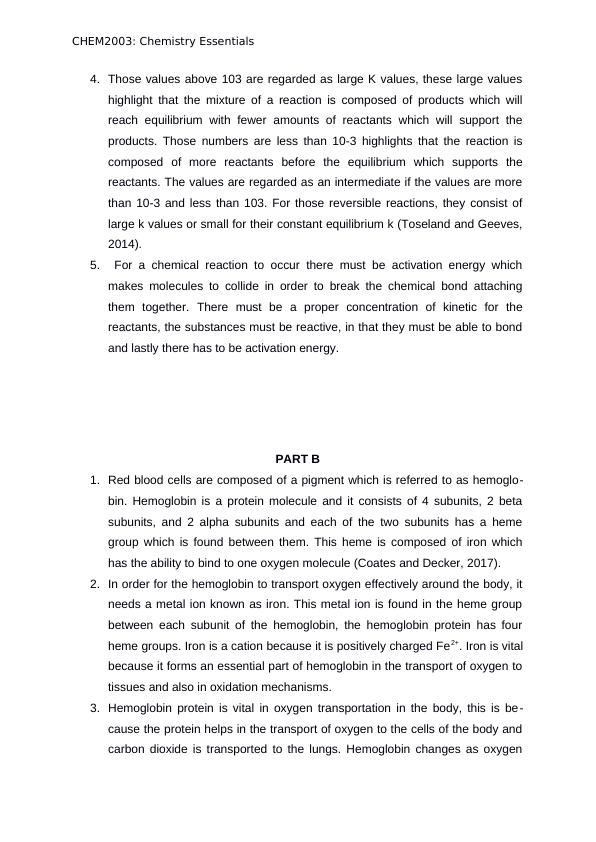Chemistry Essentials
Added on 2022-10-06
9 Pages2398 Words73 Views
Running head: CHEMISTRY ESSENTIALS 1
Chemistry Essentials
Ammika Tiwari
Chemistry Essentials
Ammika Tiwari

CHEM2003: Chemistry Essentials
PART A
1. Questions
a) A reaction is said to be at equilibrium when the forward and reverse happen at
the equal rates. When the equilibrium shift is interrupted, the equilibrium shift
will move to the direction which is prone to counteract (Toseland and Geeves,
2014).
b) There will be shifting to the right
c) There will be a shift to the left
d) There will be a shifting to the left
e) When the lungs have a high concentration of O2 which favors the equilibrium
to shift to the right side. This results in the formation of oxyhemoglobin. On the
other hand, when the hemoglobin is low in the blood, there will be the
destruction of red blood cells and as a result, there will be low oxygen hence
this will not favor the equilibrium position (Toseland and Geeves, 2014).
2. HbH+(aq) + O2
3. Formulae for calculating K.
K=HbO2÷{Hb}{O2}
K= {3.33×10-2} ÷ {1.15×10-4}{6.4×10-1}
K= 4.52×10-3
This equation needs to be written as K= 4.52×10-9
This is my approach to this question since I don’t have another I cannot be
able to approach as you have sent this picture.
Apologies as I was not very clear. It needs to be in the format as the picture,
hence I had the line.
PART A
1. Questions
a) A reaction is said to be at equilibrium when the forward and reverse happen at
the equal rates. When the equilibrium shift is interrupted, the equilibrium shift
will move to the direction which is prone to counteract (Toseland and Geeves,
2014).
b) There will be shifting to the right
c) There will be a shift to the left
d) There will be a shifting to the left
e) When the lungs have a high concentration of O2 which favors the equilibrium
to shift to the right side. This results in the formation of oxyhemoglobin. On the
other hand, when the hemoglobin is low in the blood, there will be the
destruction of red blood cells and as a result, there will be low oxygen hence
this will not favor the equilibrium position (Toseland and Geeves, 2014).
2. HbH+(aq) + O2
3. Formulae for calculating K.
K=HbO2÷{Hb}{O2}
K= {3.33×10-2} ÷ {1.15×10-4}{6.4×10-1}
K= 4.52×10-3
This equation needs to be written as K= 4.52×10-9
This is my approach to this question since I don’t have another I cannot be
able to approach as you have sent this picture.
Apologies as I was not very clear. It needs to be in the format as the picture,
hence I had the line.

CHEM2003: Chemistry Essentials
4. Those values above 103 are regarded as large K values, these large values
highlight that the mixture of a reaction is composed of products which will
reach equilibrium with fewer amounts of reactants which will support the
products. Those numbers are less than 10-3 highlights that the reaction is
composed of more reactants before the equilibrium which supports the
reactants. The values are regarded as an intermediate if the values are more
than 10-3 and less than 103. For those reversible reactions, they consist of
large k values or small for their constant equilibrium k (Toseland and Geeves,
2014).
5. For a chemical reaction to occur there must be activation energy which
makes molecules to collide in order to break the chemical bond attaching
them together. There must be a proper concentration of kinetic for the
reactants, the substances must be reactive, in that they must be able to bond
and lastly there has to be activation energy.
PART B
1. Red blood cells are composed of a pigment which is referred to as hemoglo-
bin. Hemoglobin is a protein molecule and it consists of 4 subunits, 2 beta
subunits, and 2 alpha subunits and each of the two subunits has a heme
group which is found between them. This heme is composed of iron which
has the ability to bind to one oxygen molecule (Coates and Decker, 2017).
2. In order for the hemoglobin to transport oxygen effectively around the body, it
needs a metal ion known as iron. This metal ion is found in the heme group
between each subunit of the hemoglobin, the hemoglobin protein has four
heme groups. Iron is a cation because it is positively charged Fe2+. Iron is vital
because it forms an essential part of hemoglobin in the transport of oxygen to
tissues and also in oxidation mechanisms.
3. Hemoglobin protein is vital in oxygen transportation in the body, this is be-
cause the protein helps in the transport of oxygen to the cells of the body and
carbon dioxide is transported to the lungs. Hemoglobin changes as oxygen
4. Those values above 103 are regarded as large K values, these large values
highlight that the mixture of a reaction is composed of products which will
reach equilibrium with fewer amounts of reactants which will support the
products. Those numbers are less than 10-3 highlights that the reaction is
composed of more reactants before the equilibrium which supports the
reactants. The values are regarded as an intermediate if the values are more
than 10-3 and less than 103. For those reversible reactions, they consist of
large k values or small for their constant equilibrium k (Toseland and Geeves,
2014).
5. For a chemical reaction to occur there must be activation energy which
makes molecules to collide in order to break the chemical bond attaching
them together. There must be a proper concentration of kinetic for the
reactants, the substances must be reactive, in that they must be able to bond
and lastly there has to be activation energy.
PART B
1. Red blood cells are composed of a pigment which is referred to as hemoglo-
bin. Hemoglobin is a protein molecule and it consists of 4 subunits, 2 beta
subunits, and 2 alpha subunits and each of the two subunits has a heme
group which is found between them. This heme is composed of iron which
has the ability to bind to one oxygen molecule (Coates and Decker, 2017).
2. In order for the hemoglobin to transport oxygen effectively around the body, it
needs a metal ion known as iron. This metal ion is found in the heme group
between each subunit of the hemoglobin, the hemoglobin protein has four
heme groups. Iron is a cation because it is positively charged Fe2+. Iron is vital
because it forms an essential part of hemoglobin in the transport of oxygen to
tissues and also in oxidation mechanisms.
3. Hemoglobin protein is vital in oxygen transportation in the body, this is be-
cause the protein helps in the transport of oxygen to the cells of the body and
carbon dioxide is transported to the lungs. Hemoglobin changes as oxygen

End of preview
Want to access all the pages? Upload your documents or become a member.
Related Documents
Bioscience Assignmentlg...
|10
|1767
|149
Bioscience: Equilibrium, Physiology, and Intermolecular Forceslg...
|10
|2717
|453
Chemistry Assignment 1lg...
|7
|1119
|349
